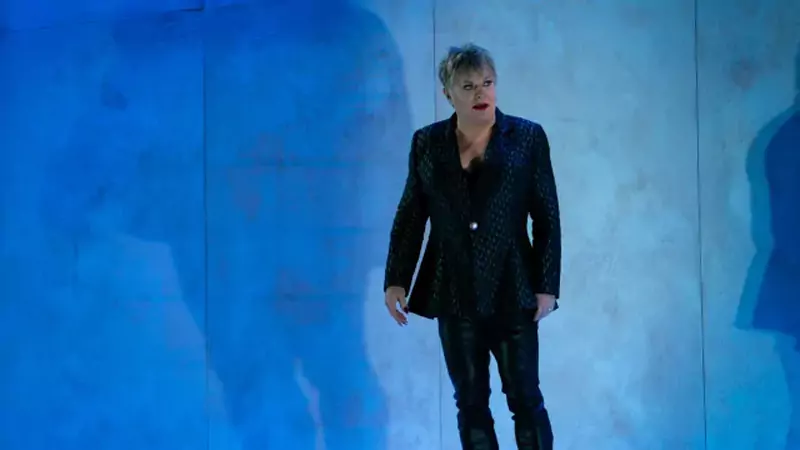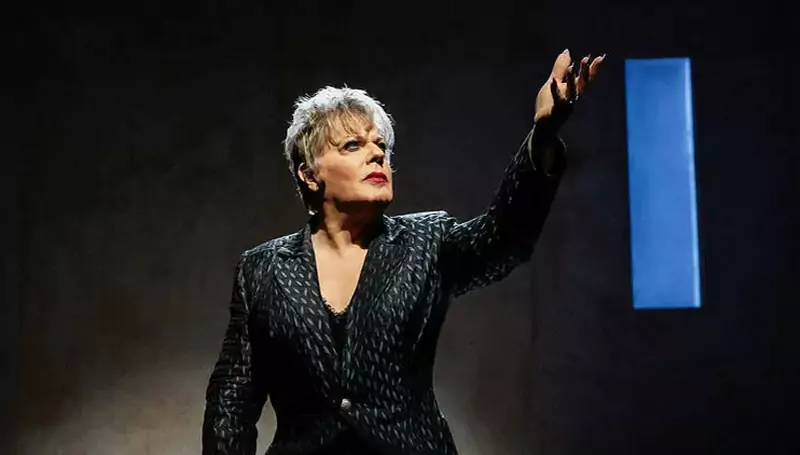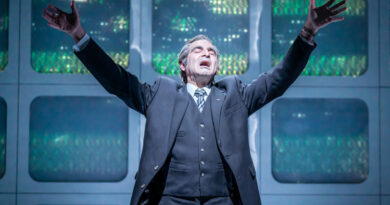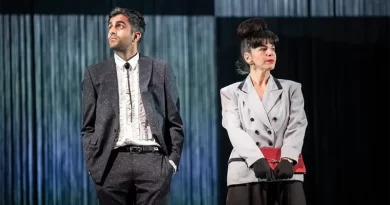“Eddie Izzard: Hamlet” at Riverside Studios
Jeremy Malies in west London
2 June 2024
“Suit the action to the word, the word to the action …” Eddie Izzard will have repeated the advice dozens of times during rehearsal, and as a piece of acting you can rarely fault this take on Hamlet in a version created by her brother Mark Izzard. But I left the theatre wondering: “Why?” Why the immense investment of resources (and accompanying hoopla) on a virtuoso performance that for me at least failed to throw any new light on the play?

Photo courtesy Riverside Studios.
“It’s not the normal progression!” she said coming out of character at the curtain call. Well, you could argue that it is at the moment, with Andrew Scott giving a one-man Uncle Vanya at Duke of York’s Theatre and Sarah Snook playing all the characters in The Picture of Dorian Gray at Theatre Royal Haymarket. Izzard herself has performed a one-person Great Expectations.
Transferring after a run at Greenwich House Theater (New York) earlier in the year, this didn’t exactly come trippingly on the tongue for press night, but Izzard had the speed of thought to dig herself out of occasional trouble. There was also quite a lot of puffing, long before Gertrude says that her son is scant of breath during the duel!
Izzard nails the longer speeches, with novel and logical line readings on the major soliloquies. I would queue to see a production that she directed. But the constant pirouetting (not mannered but simply necessary) in order to indicate which characters she was playing began to pall. Director Selina Cadell might have given the actor more movement options as she morphs between the major members of court.
I also wondered if Mark Izzard could have made some cuts, particularly to speeches that mention both young and old Fortinbras. And yet there is excessive cutting of what, for me, is one of the loveliest speeches in which Gertrude entreats Hamlet to see the death of his father as part of a cycle rather than a simple bereavement. And why has Mark Izzard introduced modernisms such as “old git” when Shakespeare’s own insults (he could have borrowed from other plays) are so rich?
It’s a brave project in that Izzard gives herself nowhere to hide in the literal sense. With the plot being full of eavesdropping (as well as Hamlet seeing Denmark as a prison) you might expect there to be a few nooks and recesses in the set by scenic designer Tom Piper. There are none; it’s a bare spearmint-coloured marble expanse with a few rectangular battlement windows. These are suffused with crimson by lighting designer Tyler Elich when there is talk of war. Elich also achieves a subtle stained-glass effect when we see Claudius at prayer. But as Hamlet says, it’s a sterile promontory and the simplicity may have gone too far. Cadell might have helped Izzard with the odd prop, perhaps a rapier or Yorick’s skull even if the skull were stylized somehow as at Southwark Playhouse (Borough) recently.
The highlight (and it’s joyous) is the gravedigging scene during which Izzard’s four years as a street entertainer kick in. She has First Clown mumble segments of the lines to himself (as repetition) before throwing them to Second Clown.
I should have liked to hear Izzard catching more of the magic that Hamlet is recalling as he asks the Player King about previous performances. And as Hamlet gestures to us, the audience, when there is mention of spectators during “The Mousetrap”, I wondered if there could have been a little pantomime-style participation. I should have liked to scream a warning to Gertrude about the poisoned drink or to Polonius in the closet scene.
Any Hamlet will be a hostage to fortune once they tell the Players not to saw the air with their hands or over-egg physical gestures. Izzard can hardly do it all with verbal mannerisms, so I suppose it’s inevitable that some of the gestures will be a little stereotypical. But vocally she runs a gamut from Polonius’s rolled ‘r’s and actor-laddie pomposity (deliberate) to Ophelia’s rage in the mad scene when she rails at having been used as a pawn during Claudius’s realpolitik.
But it’s testimony to Izzard’s prodigious technique that if this were your first exposure to the play you would be able to follow it. Izzard excels at showing the characters’ mental cogs whirring, nowhere more so than when the penny drops as Hamlet realizes that Horatio truly believes he has seen the old king’s ghost. And Old Hamlet’s experiences come across as hellish. It would be a stretch to say that my hair stood on end “like quills upon the fretful porpentine”, but my heart certainly went out to this put-upon caring monarch who is doomed to walk the night. Elich’s lighting design impresses again here; just as Old Hamlet says the glow-worms are telling him to leave, the stage is flooded with a sickly green.
There is great comic work as Izzard uses her hands glove-puppet style to represent Rosencrantz and Guildenstern. I’m probably being pedantic but wonder if this misses the essential point that the pair are spies sent to report on the prince’s movements and sanity. The technique could more usefully have been exploited to conjure up Horatio whose loyalty is unquestioned or a truly slimy Osric before the duel.
This is a serious, ethical, and skilful project that deserves to be treated with respect – especially as Eddie Izzard has had some success as a dramatic actor on stage, as well as of course multi-roling in brilliant stand-up comedy performances. There are many magical passages and I’d agree with Ophelia that the prince’s speeches are often honeyed. But as a whole the production never truly took wing for me. When Hamlet says that the time is out of joint, he is railing against the fact that as the rightful heir he is expected to fix absolutely everything that is wrong at Elsinore. Readiness is all, and a small army of world-class practitioners has been thrown at this. But however accomplished, the scope of Izzard’s project smacks of hubris.









